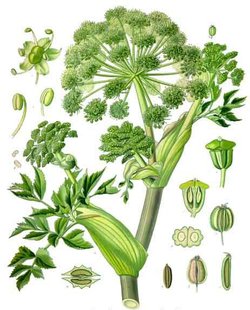Garden Angelica
|
|
| Garden Angelica | ||||||||||||||
|---|---|---|---|---|---|---|---|---|---|---|---|---|---|---|
 Garden Angelica | ||||||||||||||
| Scientific classification | ||||||||||||||
|
Garden Angelica (Angelica archangelica) is a biennial plant from the umbelliferous family Apiaceae.
It only grows leaves during its first year, and a fluted stem that grows up to two metres tall during the second year. Its leaves are composed of numerous small leaflets, divided into three principal groups, each of which is again subdivided into three lesser groups. The edges of the leaflets are finely toothed or serrated. The flowers, which blossom in July, are small and numerous, yellowish or greenish in colour, are grouped into large, globular umbels, which bear pale yellow, oblong fruits. Angelica only grows in damp soil, preferably near rivers or deposits of water.
Angelica archangelica grows wild in Finland, Sweden, Norway and Iceland, mostly in the northern parts of the countries. It is cultivated in France, mainly in the Marais Poitevin, a marsh region close to Niort in the départment Deux-Sèvres. It was probably brought to Iceland with the first settlers.
Usage/History
From the 10th century on, angelica was cultivated as a vegetable and medicinal plant, and achieved great popularity in Scandinavia in the 12th century and is still used today, especially in Samic culture. A flute-like instrument with a clarinette-like sound can be made of its hollow stem, probably as a toy for children. Linné reported that Samic peoples used it in reindeer milk. Other usages include spices.
In 1602, angelica was introduced in Niort, which had just be ravaged by the plague, and it has been popular there ever since. It is used to flavour liqueurs or aquavits (e.g. Chartreuse, Benedictine, Vermouth and Dubonnet), omelettes and trout, and as jam. The long bright green stems are also candied and used as decoration.
Angelica contains a veriety of chemicals which have been shown to have medicinal properties. Chewing on angelica or drinking tea brewed from it will cause local anesthesia, but it will heighten the consumer's immune system. It has been shown to be effective against various bacteria, fungal infections and even viral infections.
The essential oil of the roots of Angelica archangelica contains β-terebangelene, C10H16, and other terpenes; the oil of the seeds also contains β-terebangelene, together with methylethylacetic acid and hydroxymyristic acid.
Etymology
Archangelica comes from the greek word "arkhangelos" (=arch-angel), due to the myth that it was the angel Gabriel who told of its use as medicine.
In Finnish it is called väinönputki, in Sami faddnu or fadno, in English garden angelica, in German arznei-engelwurz, in Dutch grote engelwortel, in Swedish kvanne, in Norwegian kvann and in Icelandic it has the name hvönn.
